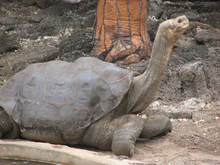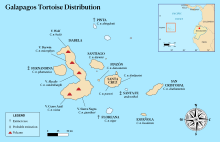This article is missing information about full genome sequenced. (December 2020) |
| Pinta Island tortoise | |
|---|---|

| |
| Lonesome George at the Charles Darwin Research Station in 2006, the last known individual of his species of Galápagos tortoise | |
| Scientific classification | |
| Domain: | Eukaryota |
| Kingdom: | Animalia |
| Phylum: | Chordata |
| Class: | Reptilia |
| Order: | Testudines |
| Suborder: | Cryptodira |
| Superfamily: | Testudinoidea |
| Family: | Testudinidae |
| Genus: | Chelonoidis |
| Species: | |
| Subspecies: | †C. n. abingdonii
|
| Trinomial name | |
| †Chelonoidis niger abingdonii | |

| |
| Map of the Galápagos Islands showing locations of different tortoise species. | |
| Synonyms[3] | |
| |
The Pinta Island tortoise[4] (Chelonoidis niger abingdonii[2][5]), also known as the Pinta giant tortoise,[2] Abingdon Island tortoise,[1] or Abingdon Island giant tortoise,[2] is a recently extinct subspecies of Galápagos tortoise native to Ecuador's Pinta Island.[1]
The subspecies was described by Albert Günther in 1877 after specimens arrived in London. By the end of the 19th century, most of the Pinta Island tortoises had been wiped out due to hunting.[6] By the mid-20th century, the subspecies was assumed to be extinct[7] until a single male was discovered on the island in 1971. Efforts were made to mate the male, named Lonesome George, with other subspecies, but no viable eggs resulted. Lonesome George died on 24 June 2012, and the subspecies was believed to have become extinct with his death.[8] However, 17 first-generation hybrids were reported in 2012 from Wolf Volcano on Isabela Island during a trip by Yale University researchers. As these specimens were juveniles, their parents might still be alive.[9][10] The subspecies is classified as extinct on the IUCN Red List.[1]
- ^ a b c d Cayot, L.J.; Gibbs, J.P.; Tapia, W.; Caccone, A. (2016). "Chelonoidis abingdonii". IUCN Red List of Threatened Species. 2016: e.T9017A65487433. doi:10.2305/IUCN.UK.2016-1.RLTS.T9017A65487433.en. Retrieved 2023-01-22.
- ^ a b c d van Dijk, Peter Paul; Iverson, John B.; Shaffer, H. Bradley; Bour, Roger; Rhodin, Anders G. J. (2011). "Turtles of the World, 2011 Update: Annotated Checklist of Taxonomy, Synonymy, Distribution, and Conservation Status". In Rhodin, Anders G.J.; Pritchard, Peter C. H.; van Dijk, Peter Paul; Saumure, Raymond A.; Buhlmann, Kurt A.; Iverson, John B.; Mittermeier, Russell A. (eds.). Conservation Biology of Freshwater Turtles and Tortoises. Chelonian Research Monographs, Number 5. pp. 000.165–000.242. doi:10.3854/crm.5.000.checklist.v4.2011. ISBN 978-0-9653540-9-7. OCLC 472656069. S2CID 88917646.
- ^ Cite error: The named reference
Reptariumwas invoked but never defined (see the help page). - ^ Reynolds, Robert P.; Marlow, Ronald W. (1983). "Lonesome George, the Pinta Island Tortoise: A Case of Limited Alternatives". Noticias de Galápagos. 37: 14–7. Archived from the original on 2017-10-28. Retrieved 2012-06-26.
- ^ Cite error: The named reference
Fritz07was invoked but never defined (see the help page). - ^ Nicholls, Henry (2007). Lonesome George: The Life and Loves of the World's Most Famous Tortoise. London: Pan Books. p. 2. ISBN 978-0-330-45011-9.
- ^ Hinckley, Story (2015-10-22). "14 animals declared extinct in the 21st century". Christian Science Monitor. ISSN 0882-7729. Retrieved 2017-05-16.
- ^ Jones, Bryony (25 June 2012). "Lonesome George, last of the Pinta Island tortoises, dies". CNN. Retrieved 25 June 2012.
- ^ "Galapagos Tortoise 'Lonesome George' May Have Company". LiveScience. 2012-11-15. Retrieved 2023-01-22.
- ^ "Breeding Efforts May Resurrect Giant Tortoise Species". Island Conservation. 2016-07-26. Retrieved 2023-01-22.
